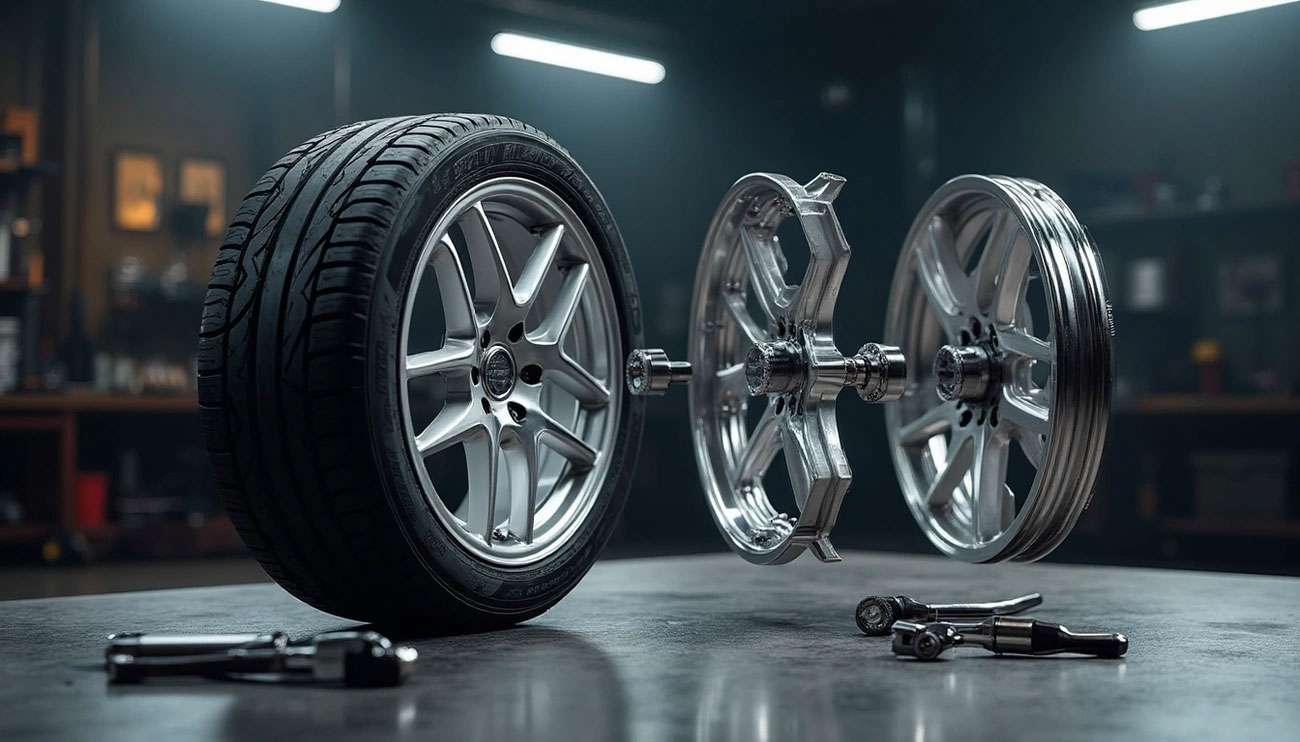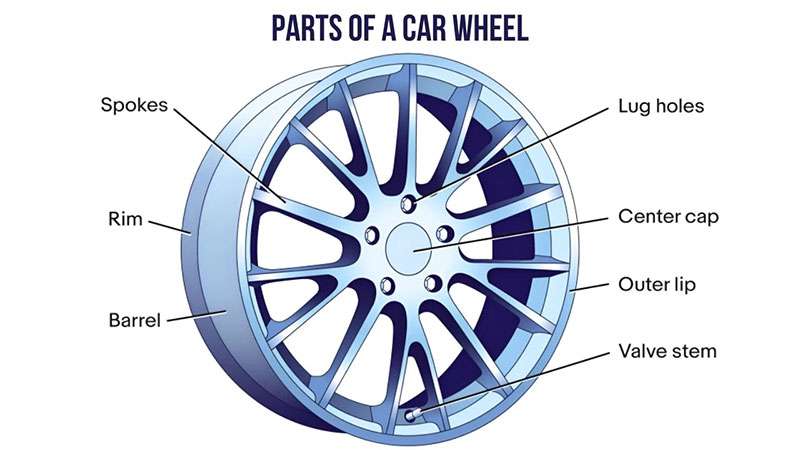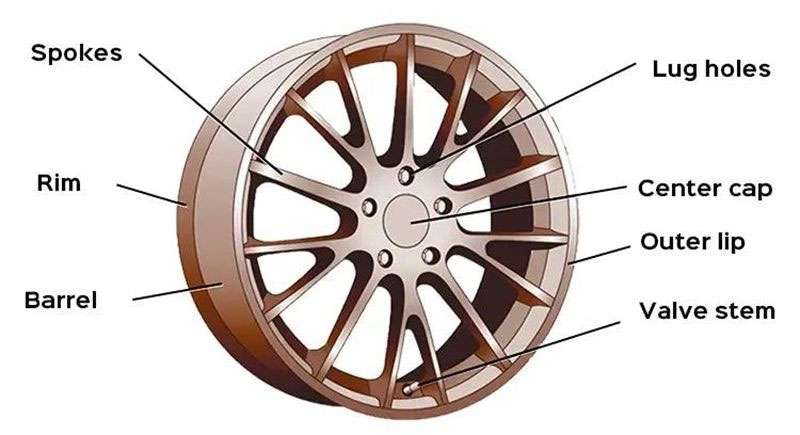
Vehicle owners frequently mix up rims and wheels when discussing their cars or trucks. These terms get tossed around interchangeably, yet they actually describe completely different components of your vehicle. The rim represents the outer edge that secures your tire in position, while the wheel encompasses the entire metal assembly featuring the rim, spokes, and additional structural elements.
Getting the terminology straight matters more than you might think. Proper identification leads to better maintenance decisions and smarter purchasing choices for your vehicle. The rim serves a critical function by creating an airtight seal for tubeless tires and delivering essential support to the complete wheel structure. Vehicle owners often ask whether wheels and rims mean the same thing, but the rim functions as just one part of the total wheel assembly. Since impacts with potholes or road debris cause most rim damage, understanding which component requires attention can save you both time and money when problems occur.

Image Source: The Engineering Choice
Most drivers misidentify a crucial component located at the outer edge of their wheel assembly. The rim describes specifically the outermost circular section that makes direct contact with your tire. Rather than encompassing the complete wheel structure, the rim functions primarily as the mounting foundation where your tire attaches securely.
Rims serve purposes that go well beyond visual appeal. This essential component creates a distinctive U-shaped profile when seen from the side, featuring a deeper center section that slopes gradually toward shallower edges. Manufacturers typically construct rims from the same materials used throughout the wheel—commonly steel, aluminum alloy, or specialized carbon fiber—and frequently apply protective coatings during production to boost long-term durability.
The rim establishes and maintains a critical airtight seal connecting your tire to the wheel. This sealing capability proves vital for tubeless tires, guaranteeing proper air pressure and preventing unwanted leakage during normal driving. Your vehicle's handling characteristics also depend significantly on rim dimensions and design specifications.
Three primary components work together to form the complete rim structure. The barrel creates the main section spanning from the outboard face to the inboard rim edge, establishing the structural base where tires mount properly. This area incorporates specialized features like the drop center that simplifies tire installation procedures.
Flanges form the raised edges that extend outward at precise 90-degree angles on each side of the barrel, creating barriers that keep tires from sliding off during operation. These edges provide essential safety functions while contributing to the wheel's overall appearance.
Beads represent the flat mounting surfaces positioned directly inside the flanges where tire edges (also called beads) establish contact. These areas require careful maintenance since they handle critical force transfer between your tire and wheel assembly.
Rims incorporate multiple design features to maintain secure tire attachment. Small raised ridges known as mounting humps run around both sides of the barrel, forming protective barriers that prevent tires from shifting away from the wheel edges. Today's passenger vehicles commonly use one-piece rims featuring "safety" profiles with humps that extend inward toward the opposite tire bead seat.
Applications demanding maximum security—including off-road driving or drag racing—benefit from specialized beadlock systems that mechanically clamp the tire bead directly to the rim, dramatically reducing the risk of separation.

Image Source: AutoProtoWay
The complete wheel represents a far more sophisticated assembly than most people realize. This integrated system combines multiple precision-engineered components that work together to support your vehicle's weight and deliver smooth performance on every road surface.
At the heart of every wheel sits the hub, which contains the essential mounting point where your wheel connects to the vehicle's axle. This central component houses critical mechanical elements like wheel bearings that allow for smooth, friction-free rotation.
Spokes extend outward from the hub to create the vital connection between the center and outer rim. These structural elements do double duty—they provide the necessary strength to handle road forces while creating the distinctive visual patterns that define different wheel styles.
The center disk (also known as the plate) incorporates the lug holes where mounting bolts secure the wheel to your vehicle. You'll often find manufacturer logos displayed here on a center cap that shields internal components from road debris and moisture.
Many drivers don't realize the rim serves as just one component within the complete wheel assembly. The wheel includes every part of the metal structure, while the rim specifically describes only the outer circumference where tire mounting occurs.
Breaking down these components helps clarify what you're actually discussing:
Wheel: The complete metal assembly that bolts to your axle, including hub, spokes, and rim
Rim: Only the outer edge section that makes contact with and holds the tire
Tire: The rubber component that mounts to the wheel's rim and provides road contact
When someone says they're "getting new rims," they usually mean replacing the entire wheel assembly rather than just the outer mounting edge.
Language mix-ups between wheels and rims run deep throughout automotive culture. Even seasoned car enthusiasts debate proper usage, showing just how embedded these terminology habits have become.
Where you live plays a major role in how you describe vehicle components. Car owners across different forums point out that regional dialects shape terminology—what's called a "wheel" in one area might be commonly referred to as a "rim" elsewhere. Germany distinguishes between "Reifen" (tire), "Felge" (rim), and "Rad" (wheel), while Spanish-speaking regions show similar differentiation with terms like "rueda," "llanta," and "rin" varying by country.
The confusion stems primarily from automotive aftermarket culture. When custom wheels gained popularity, the term "rims" gradually moved from niche communities into everyday vocabulary. The phrase "nice rims" became a standard compliment for attractive wheels. Music, media, and marketing accelerated this shift by popularizing aftermarket modifications. Custom wheels with dramatic rim styles—deep dish, high offset—led many people to refer to the entire assembly by its most eye-catching feature.
Technically, no—though they're commonly used interchangeably. The confusion continues partly because, as one automotive enthusiast noted, "I need a new set of rims" somehow sounds more appealing than requesting wheels. Precision matters: wheels include the entire metal assembly with hub, spokes, and rim, while the rim refers strictly to the outer edge holding the tire.
Early damage detection saves you from expensive repairs and hazardous driving situations. We recommend regular inspections to catch problems before they become dangerous or costly.
Vibrations through your steering wheel or seat indicate bent rims. Small deformations create noticeable shaking that worsens at higher speeds. Persistent air leaks present another clear warning—when tires lose pressure repeatedly without visible punctures, the rim likely has damage. Watch for these additional warning signs:
Strange sounds like clicking, thumping, or grinding from the wheels
Vehicle drifting or pulling to one side
Irregular tire wear patterns
Damaged wheels create problems beyond just comfort. Bent wheels reduce your fuel efficiency and compromise braking performance. Structural damage affects vehicle stability, particularly during emergency situations when you need maximum control. These problems eventually damage other components like suspension and steering systems.
Steel wheels with minor bends can sometimes be repaired, but aluminum wheels usually need complete replacement when damaged. Small cosmetic problems like scratches or scuffs might only require rim repair. However, cracks or structural damage demand full wheel replacement for safety. Getting this decision right matters—compromised wheels increase accident risk and can cause dangerous blowouts.
We recommend professional inspection when you notice any damage signs. Our experienced technicians can determine whether repair or replacement provides the safest, most cost-effective solution for your specific situation.
Characteristic | Rim | Wheel |
Definition | The outer edge that holds your tire in place | Complete metal assembly including rim, spokes, and all components |
Main Components | - Barrel | - Hub |
Primary Function | - Creates airtight seal with tire | - Connects to vehicle axle |
Common Materials | - Steel | Same materials as rim components |
Signs of Damage | - Air leaks | - Strange noises |
Common Cause of Damage | Impacts with potholes or road objects | Same impacts affecting the complete assembly |
Repair vs Replace | Minor cosmetic damage can often be repaired | Structural damage requires complete replacement |
Relationship | One component of the wheel | Complete assembly that includes the rim |
Getting the terminology right between rims and wheels delivers real value beyond just sounding knowledgeable. We've established that wheels represent the complete metal assembly that connects to your vehicle's axle, while rims specifically describe the outer edge where your tire mounts securely. This distinction, while seemingly minor, directly impacts your maintenance choices and replacement decisions.
Rims handle the critical job of sealing your tire and providing structural support through their barrel, flanges, and beads. When this component suffers damage, you'll typically notice air leaks, steering vibrations, or irregular tire wear. The complete wheel assembly includes additional parts like the hub, spokes, and center disk that work together to support your vehicle's weight and ensure smooth operation.
Regional terminology differences and aftermarket culture have made "rims" popular slang for entire wheel assemblies. However, knowing exactly which component needs attention saves you both time and money when issues develop. Cosmetic damage might only require rim repair, while structural problems demand complete wheel replacement for safety.
Early detection of problems like steering vibrations or persistent air leaks prevents more serious issues later. Strange noises, vehicle pulling, and reduced fuel efficiency all indicate wheel problems that need immediate professional attention.
When someone admires your "nice rims," you'll understand they're referring to just one part of your wheel assembly. This knowledge makes you a more informed vehicle owner and helps you communicate clearly with mechanics and service professionals. Precision in automotive terminology leads to better maintenance decisions and safer driving experiences for you and your family.
Understanding the difference between rims and wheels helps you make better maintenance decisions and communicate effectively with mechanics about your vehicle's needs.
• Rims are just one part of the wheel - The rim is the outer edge that holds the tire, while the wheel is the complete metal assembly including hub, spokes, and rim.
• Watch for specific damage signs - Steering wheel vibrations, persistent air leaks, and uneven tire wear typically indicate rim damage requiring attention.
• Terminology confusion is common but costly - While people use "rims" and "wheels" interchangeably, knowing the difference helps you get the right repairs and avoid unnecessary expenses.
• Repair vs replace depends on damage type - Minor cosmetic rim issues can often be repaired, but structural wheel damage requires complete replacement for safety.
• The rim creates the tire seal - This outer edge component maintains air pressure in tubeless tires through its barrel, flanges, and bead design.
When discussing vehicle maintenance or shopping for replacements, using precise terminology ensures you get exactly what your vehicle needs while avoiding miscommunication that could lead to wrong parts or inflated repair costs.
A rim is the outer edge of a wheel that holds the tire in place, while a wheel is the entire metal structure that includes the rim, spokes, hub, and other components. The wheel attaches to the vehicle's axle, supporting its weight and enabling motion.
The term "rims" became popular slang for wheels due to aftermarket trends and regional dialects. Custom wheel designs with distinctive rim styles led many to refer to the entire assembly by its most visually striking feature. However, technically, they are not the same thing.
Signs that your rims may need replacement include persistent air leaks, vibrations in the steering wheel or seats, and uneven tire wear. If you notice these symptoms, it's important to have your vehicle checked by a professional to determine if rim replacement is necessary.
Yes, rim materials can impact performance. Common materials include steel, aluminum alloy, and occasionally carbon fiber. Aluminum alloy rims are typically lighter than steel, which can improve fuel efficiency and handling. However, the best choice depends on your specific vehicle and driving needs.
Under normal conditions, a set of rims can last around 10 years. However, factors like impacts from potholes, curb damage, and corrosion can significantly shorten their lifespan. Regular inspections and proper maintenance can help extend the life of your rims.